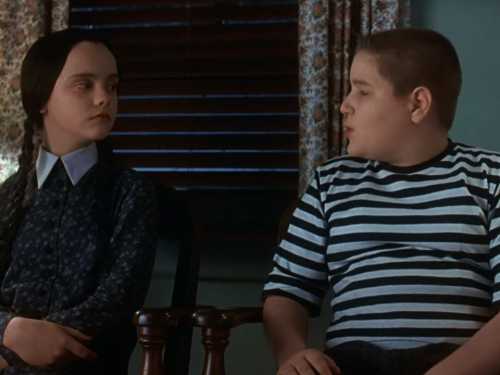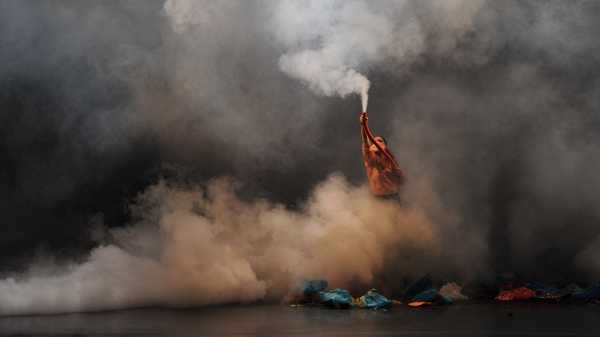
Trying to see every play in January is a fool’s errand. The various experimental-theatre festivals all happen at once. Even if you run from pillar to post, you’ll miss something—some dreamy chamber opera, or thoughtful monologue, or naughty drag cabaret that mashes up Mary Shelley’s “Frankenstein” with the Smiths’ album “The Queen Is Dead.” (Salty Brine’s punchy little sparkler at Joe’s Pub, “Bigmouth Strikes Again,” plays through January 20th.) Under the Radar alone contains more than two dozen offerings, from pieces that are still in development to robust touring productions. All you can really do is fling yourself into the maelstrom and hope that when the waves wash you to shore you’re still clinging to some shred of meaning.
The New Yorker’s co-theatre critic, Vinson Cunningham, and I chatted recently about four shows that we both saw. All were projects that explored forms of instability: the shakiness of history, of human endeavors, and of time itself. We talked, and sometimes disagreed, about the artists’ tactics, but the four pieces each led us back to similar preoccupations with language, with intelligibility, with the performer’s voice, and with what lies beyond our comprehension. —Helen Shaw
Helen Shaw
One thing Under the Radar usually promises is international programming. The festival offers a great, big lamplight view of what’s going on in experimental theatre. So Under the Radar programmed this U.K. production from the Royal Court Theatre, Jasmine Lee-Jones’s “seven methods of killing kylie jenner,” which was supposed to come a year ago, but then the 2022 festival was cancelled because of COVID. Now it’s finally here.
The show is two girls in a room. One of them (Leanne Henlon) has posted something online; she is enraged by a news article about Kylie Jenner being a self-made billionaire, and she has tweeted some homicidal fantasies. Her friend (Tia Bannon) has shown up to persuade her to take the tweets down.
What did you think? Did you like it?
Vinson Cunningham
Keeping with the theme of internationality, what I loved about it was its language and its diasporic view of what the Internet is. “jenner” gives an international view of this pidgin that we’ve all put together by living online; the performers talk both through words and through images—rendering, almost sculpturally, all those memes that we’ve become accustomed to. I love Black British slang because of its reliance on West Indian slang. It’s such a rich and, I think, beautifully verbal play. And because it has so much to do with speech codes, and the question of who can say what (and what can get you in trouble online), I just thought it was wonderful to hear how things that you think of as homegrown travel across the world and come back.
Helen Shaw
The characters sometimes talk in person; they sometimes are in the “T.L.,”' or the timeline of the Twitter feed, where the Internet-speak is so dense it’s as though you’re listening to opera. You’re hearing a language which you’re just close enough to that you can understand what’s being said, but certain subtleties of communication are lost.
And, as in opera, I wanted supertitles! Internet lingo is born out of the way writing looks—it’s full of anagrams, of puns, of distorted spelling, of initialism. So I wanted to see it! One big problem I had with the production is that it was so amplified and echoing and distorted, particularly in the online scenes, that I sometimes couldn’t hear the language at all because it was lost in reverb.
Vinson Cunningham
Maybe we’re different on that—I liked that something familiar to me on the page felt strange in real life, especially because there’s two levels of the play: the in-person in this room, and one of them basically performing online. As the two in the room get angrier at one another, their language gets more and more Internet-derived, lots of TBH (“to be honest”) and things like that. They lack the language for true confrontation and the language that friendship usually teaches us, so they go more and more into this other language. They’re using a mode of argument that works in one place and trying to apply it IRL.
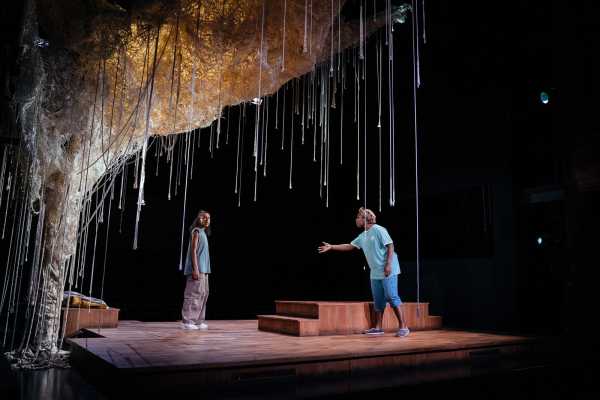
A scene from “seven methods of killing kylie jenner.”
Photograph by Helen Murray / ArenaPAL
Helen Shaw
If I were a less selfish audience member, I would be excited by the way incomprehension is also a part of online discourse. Lee-Jones is deliberately making that point: people watching online conversations play out don’t always understand them, but they weigh in anyway. But I am selfish. I want to be able to understand every line. I want to be able to write it in my little notebook, so I can look at it later!
So let’s talk about “Moby Dick” by Yngvild Aspeli’s French-Norwegian puppet company Plexus Polaire. This one was a hit. My audience was packed. It was in a huge theatre, the Skirball Center at N.Y.U., and it felt totally full! Do you have a relationship with this book? Is this something where you said, “Ah, yes, my old friend”?
Vinson Cunningham
I do love Melville, and I love this book. And, for that reason, the thing that sort of jarred me was that it doesn’t start with “call me Ishmael”! Instead, it starts with a collage of other lines. A murmuring-singing-moaning chorus comes out, and they sing other lines from the book—and I was like, “Are they gonna call him Ishmael? Is it gonna be a drizzly November in this man’s soul or not?” That was my first worry, which was quickly allayed, but I still think, You have to start there.
Helen Shaw
Well, and when our guy does come out, he is dressed as Where’s Waldo Goes to Williamsburg: little woollen beanie, cute cuffed pants. Everything else is very strange and otherworldly—the stage is muffled in what looks like planes of black velvet, and the puppets have these strange, harsh faces. But then Ishmael himself is just . . . Caleb from Starbucks.
Vinson Cunningham
We should say that in this production, Ishmael is the only person who presents him- or herself as a human presence. Everybody else is a matter of puppets and projections. Ahab is presented as one of two puppets—one upstage, on a platform, whom we’re supposed to understand as being seen from farther away, and the second when he’s downstage, where he’s a much larger puppet, animated by more than one person. And all the other shipmates, Queequeg and everybody else, are also being represented by puppets.
Helen Shaw
By playing with proportions, they make the stage feel deep. They’re often asking you to look at the stage as though you’re looking with a bird’s-eye view. You see whaling sequences from above; you see the ship from above. When people fall overboard, you see tiny figures from what feels like a very great distance. That illusion of depth I found exciting—the way they made the reach of the stage feel like the bottomlessness of the ocean. The very first puppet that you see is a school of glittering white fish that shimmer and quiver for an instant, and then they snatch themselves away into the darkness. Whales, shmales—that, for me, was the most animal and mysterious moment of the whole ninety minutes.
Still, as intensely beautiful as the production was, I’m not sure I spent a lot of the time thinking about the inhuman “unknown,” even though Ishmael tells us that’s what it’s all about.
Vinson Cunningham
In Melville, you’re always wondering about the operator behind the darkness—is someone moving what I’m seeing? And here, interestingly, some of that mystery is taken out of the text and put into the process of the playwright. The mechanics of the puppetry become the mystery—
Helen Shaw
Become the metaphysics, right? All those many hands manipulating these little human fates.
Vinson Cunningham
I do think there was an otherworldliness in the music. There’s a double-bass being bowed on one side (Guro Skumsnes Moe), and someone’s on a variously distorted electric guitar (Håvard Skaset). And on the other side of the stage, there’s a percussionist (Ane Marthe Sørlien Holen), and the musicians are also singing a sort of meowing harmony all the way through. I was thinking about whale song, the mysterious rumbling in the deep. Sometimes it’s very clear harmony; sometimes it’s not. I was looking at those musicians a lot—sometimes to the exclusion of what was happening on the stage.
Helen Shaw
So, speaking of the internationality of this festival, three of the four shows we’re going to talk about are from overseas. We both saw the palindromic “Are we not drawn onward to new erA,” which is an Ontroerend Goed piece from Belgium, presented at BAM. That’s a show where you understand pretty quickly what’s going on: the first half is a play that goes forward and the language sounds garbled, and the second half is a video of that first half, but played backward, which reorganizes their sounds into English.
I’ve already written about it, but I’ve also been wondering about it in the time since, particularly whether or not I think it’s a good thing that it gives you so much time to think in the second half, because you don’t have to anticipate anything. All that time you would normally spend thinking about what’s going to happen in a play, you don’t have to do any of that, so you wind up thinking other thoughts—about climate catastrophe, say, or the way time’s arrow works. But I’ve talked to a couple of people who said it felt like a gimmick. I’m wondering what your experience was.
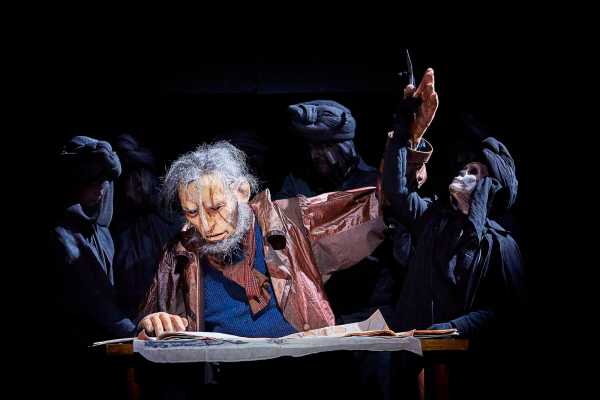
A scene from “Moby Dick.”
Photograph by Christophe Raynaud de Lage
Vinson Cunningham
I mean, I guess it happens along the grooves of a gimmick? The rough chronology of the show is there’s a single apple tree, which is very Edenic, and then you see lots of things, plastic bags and smoke—all these things arrive onstage. And at the end of the live action (which is the middle), there’s a big metallic statue, a kind of golden calf—it’s very Genesis to Exodus. But I was just totally blown away by the process of the performance. I did do a lot of that extratextual, extravisual thinking: most of it was along the lines of pushing myself backward to the origins of the performance—like, O.K., what did they have to do first in order to arrive at this? So they had to speak, and they had to do the action forward, and then have it backwardized, and then listen to that, and study certain gestures.
So, for me, this was a showcase for the body and the voice—particularly how you can achieve a kind of abstraction that’s nonetheless based on representation. That was exciting, and I walked away from it being so impressed by those people. Whereas, conceptually . . . once I realized the drama was all symbolic, I’m like, “O.K.: tree, disappointment, statue. How much meaning can I glean from these symbols?”
Helen Shaw
The idea I got stuck on was: Are they saying that we have to erase humanity in order to heal the wounds that we’ve made on the Earth? And I’m not sure if that’s what they’re saying, but it got me really paralyzed, since I’m not, you know, pro-genocide. And the reason I like theatre more than any other art form is that you can’t get out. You can’t leave. Once you get trapped in a thought, you are going to have to sit there for the rest of that time allotted to the show, and you are going to have to think that damn thought.
Vinson Cunningham
The big surprise to me was the matter of the exits. Even though I understood that events would eventually move backward, I still took the entrances (that, in reverse, would become exits) for granted. It makes you think about the void on either side of the entrance and the exit which is, you know, the void before birth and the one after death, the prehuman and whatever comes after us. That did make me gasp.
Helen Shaw
So the fourth show we’re discussing, “KLII,” Kaneza Schaal’s piece about King Leopold, is also interested in the darkness in the before and the after. Even before we encounter a performance in that show, there’s a long kind of procession: the audience walks down a dark corridor, we are directed to a series of buckets, and we ceremonially wash our hands with soap. It winds up being a big portion of the production, time-wise. How did that prelude shade what you saw after?
Vinson Cunningham
Well, first of all, it made me feel like I usually feel about things like this, which is super-corny. When one of the performers passed me the soap, I thanked him, but he didn’t say anything back. Of course he didn’t; he wasn’t a restroom attendant in a club. So I was working on my embarrassment about that until the show started. But I knew from the way that Schaal tends to work that the soap idea would come back, though it took a while to pay off. Did it make more meaning than that for you?
Helen Shaw
Well, today’s theme is that I’m a selfish audience member, and I find my time in a theatre so precious that I get very resentful when there is a hollow space where I think a show should be. So, in the case of this piece, we knew going in that it was very, very short—it’s only a sixty-five-minute show. And it takes a quarter of an hour to get everybody’s hands washed! Now, the soap thing does eventually return as an idea, since it’s a reference to King Leopold II’s great foul stain in Congo, the palm-oil plantations there, and the way Unilever’s commercial-soap empire was founded on mass murder and colonial abuses. But, by the time the show began, I was not in the place where I usually am when the lights go down: anticipation and quiet and confusion. Instead, I was in a state of time-checking and annoyance.
There’s a ten-minute movement section, with Schaal in a false gray beard, wearing a long red gown covered in sashes and medals. And then the next, I would say, twelve minutes of spoken performance are super-distorted, to the point that it’s impossible to understand. Schaal is delivering (or lip-synching?) a speech that is partly a Mark Twain satire of Leopold, I think. But all of that, for me, was obscured; I was only hearing little filtered sections, able to hang my comprehension on only a couple of words here and there. And that increased my impatience, because, again, I’m so eager to get started with the show. And I felt like I kept getting prevented from that beginning.
Vinson Cunningham
Yeah, there are many beginnings: there’s that ritualized movement, and Schaal ends up at the top of the set of stairs, then the imperial skirts of King Leopold flow down to obscure the rest of the ladder, and a bunch of microphones unfold in front of Schaal-slash-Leopold. It’s like a drag aesthetic—what I wrote down was “choreography of fascism.” You see the precision in certain gestures that I think is really artfully carried through.
You listen, and you try to hear, and there’s a sort of AM radio effect. I always teach at least one sermon in my classes because I’m obsessed with oratory as an agent of compulsion. So this is stuff I’m primed to think about. I grew up listening to sermons all the time and watching the gestures of people that were trying to make me think things. So that was my headspace. Even though I wasn’t in the sort of watchful, waiting position that I usually am at the beginning of the show, for me it was interesting.
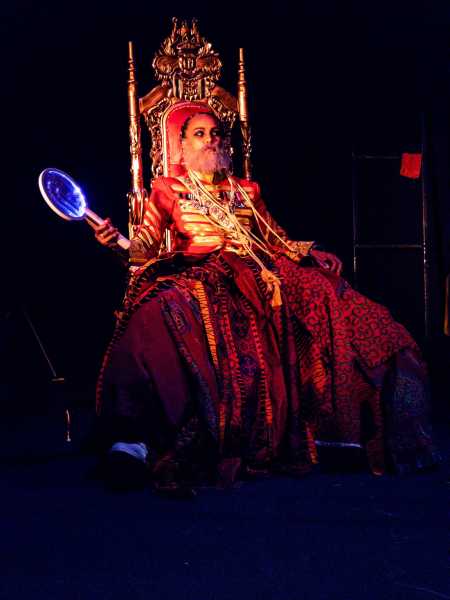
A scene from “KLII.”
Photograph by Credit Christopher Myers
Helen Shaw
And then she comes down, she takes off the beard (the costume design, by her co-director, Christopher Myers, is really astonishing), and then she starts to speak as herself—she tells us about her grandfather, who was a much-beloved community figure who left Rwanda for Burundi, where he kept an auberge. The more conversational stuff was thoughtful, though whenever it took on a more portentous language about songs-beneath-songs, for instance, the writing gets pretty thin.
Still, that quarter of an hour is actually the meat. Schaal’s . . . delay in getting to content does do something interesting, because I had to continue thinking about this sequence after rather than during the show. I haven’t lost my annoyance—I keep thinking, This emperor has no clothes—or, rather, The emperor only has clothes and a twelve-minute text! But I do think it’s intentional that I’ve continued to think about the show, even with irritation, in a fashion that I do not with shows that have more beautifully shaped beginnings, middles, and ends.
Vinson Cunningham
That does seem to be part of its ethos, right? At the end, she’s talking about the grandfather, this great neighborhood presence, drinking hibiscus tea, listening to speeches of Patrice Lumumba on a record player. And it’s in French. I’m sure someone in the audience understood it, but I don’t get too far with my French. So there was an almost archival ethos that made me want to go and find those things—a footnote to track down.
Helen Shaw
One of the things that the pandemic did is freeze things in funny places, including language. “seven methods” was supposed to come to the Public last year, and we can hear how the online pidgin has changed just in the months between then and now. You talk about archive, and theatre is an archive that is constantly in a state of being destroyed. It compels you to look backward at the beginning, even as you’re experiencing it. You talked about watching “Are we not drawn” and thinking, Wait, how did this project even incept? I don’t have that question when I’m reading a book; I never have that feeling when I’m watching a film. But in theatre you’re constantly thinking about the moment in which something was born. Under the Radar has reminded me how that element is always there. Because it’s always fun . . .
Vinson Cunningham
. . . to start thinking about beginnings. ♦
Sourse: newyorker.com
